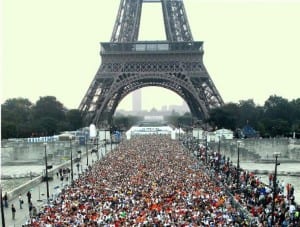People move. All the time. Wouldn’t it be great to harness that movement and help power our cities with the movement of people living in them?
The Paris Marathon was held on Sunday, and the organizers laid down some special tiles across the course. While runners are concerned with charging their internal batteries with carbs and sustaining them with goo, their footsteps charged other batteries:
The flexible tiles made from recycled truck tires will span a portion of the Champs Elysees for about 25 meters (82 feet) of the 42.2-kilometer course, according to Pavegen Systems Ltd., the U.K. maker of the tiles. Each footstep generates as much as 8 watts of kinetic energy, which is fed back to batteries that can charge display screens and electronic signs along the route, the company said.
While each footstep only generates 8 watts of energy through the kinetic motion of the runner stepping on the tile, there will be 40,000 runners passing over those tiles. Pavegen CEO Laurance Kemball-Cook invented the technology, and hopes to provide an easy way to generate electricity, regardless of weather. There is a contest to see who can guess how much energy the marathon will generate.

The largest demonstration of this type of kinetic energy occurred during the London Olympics. The cost of the panels remains high, though Pavegen is aiming to bring it down to the cost of similar tile flooring. It is also turning to Kickstarter to install panels at schools in the UK.
A Kenyan inventor patented technology that converts the bending of a sneaker into piezoelectric energy to charge a cell phone directly, or a battery to charge other things once the shoes come off. DARPA is funding research into other piezoelectric generators that convert kinetic energy directly into chemical storage without the need for a separate battery.
Existing commercial products use the power of someone pedaling a regular bicycle to charge their smartphone and a light. A new kind of soccer ball allows you to kick it and then charge a battery that will power an LED light. The ball is only one ounce heavier than a normal one.
Because each of these examples are so low-wattage on their own, this type of technology will truly become useful once it scales and lots of people wear shoes that charge their phones while walking on pavement that charges batteries to power lights.
However, if most of our power continues to be generated by burning the fossil fuels that cause global warming, sporting events could be in danger. The New York City Marathon was cancelled in the wake of Superstorm Sandy, and the Winter Olympics have started to consider stockpiling snow to avoid having to cancel events.
This article was originally posted on Climate Progress. Re-posted with permission.










